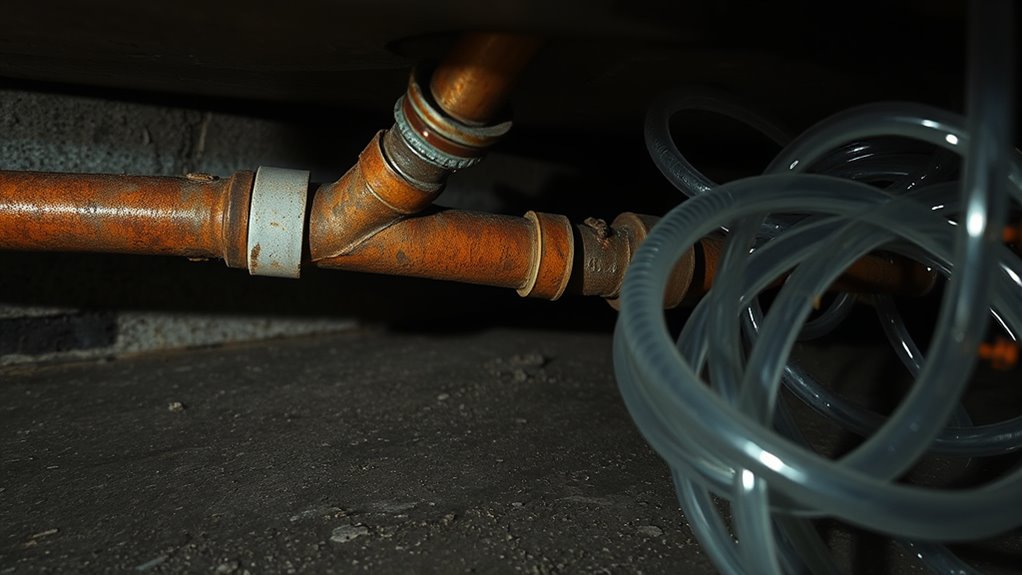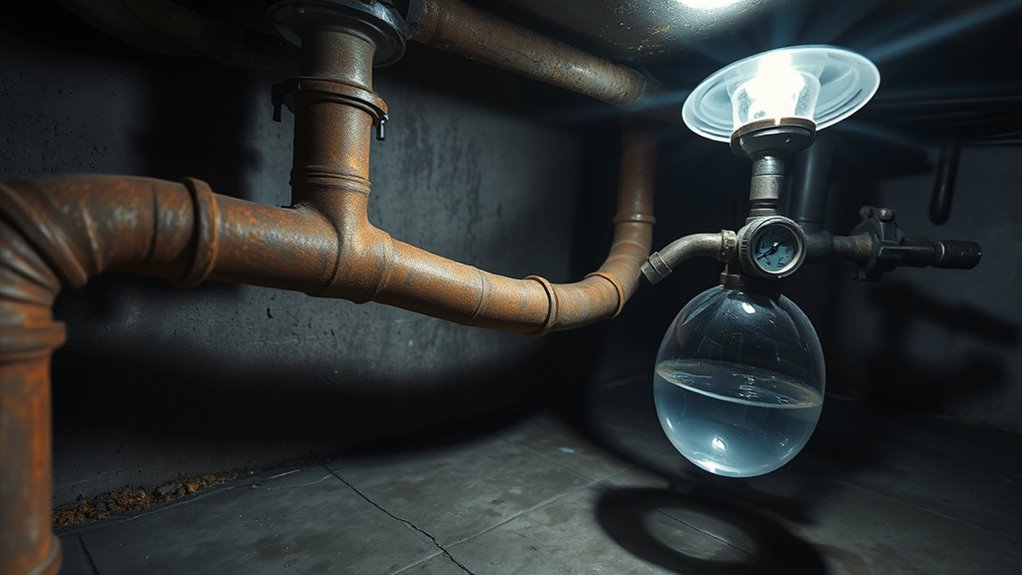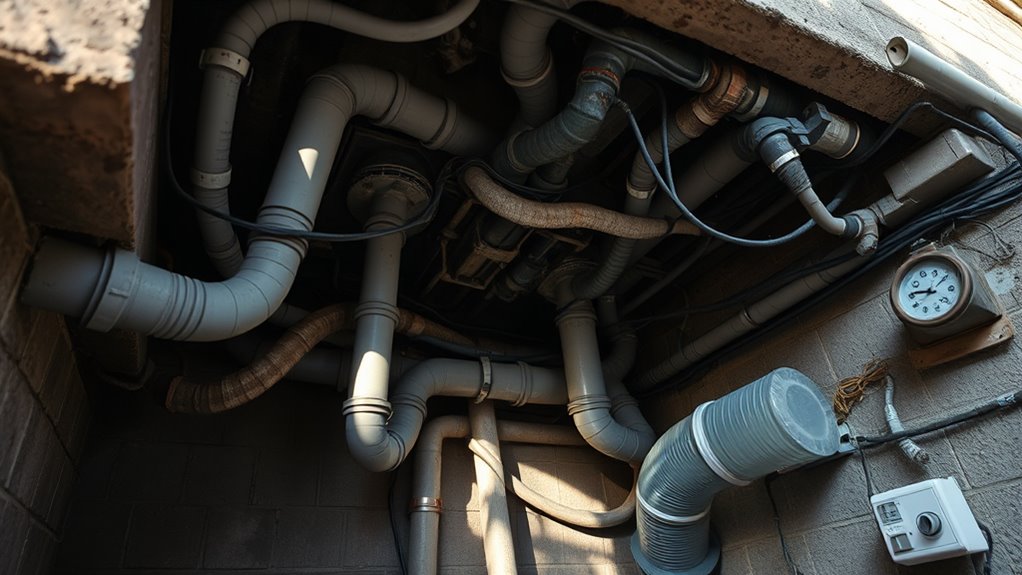If you overlook waste line maintenance, costly blockages, leaks, and odors can develop gradually, leading to unexpected expenses. Excessive make-up water raises utility bills and damages equipment over time, while unmonitored power use from pumps, lighting, and HVAC quietly drains your budget. Regular inspections, water management, and energy-efficiency upgrades can prevent these hidden costs from piling up. Staying proactive guarantees your system runs smoothly and saves money—discover how to avoid these pitfalls next.
Key Takeaways
- Neglected waste lines can cause costly blockages, leaks, odors, and health hazards over time.
- Excessive make-up water leads to higher utility bills and mineral buildup damaging equipment.
- Unnoticed power use from equipment running continuously increases operating costs and reduces efficiency.
- Poor maintenance results in hidden sanitation issues, water damage, and emergency repair expenses.
- Proactive inspections and upgrades can prevent failures, improve efficiency, and save long-term costs.
The Hidden Impact of Waste Line Maintenance

While waste line maintenance might seem like a straightforward task, neglecting it can have hidden costs you might not immediately see. Over time, buildup from debris, grease, or corrosion can cause blockages or leaks, leading to costly repairs. These issues often develop gradually, making them easy to overlook until they escalate into major problems. When waste lines aren’t properly maintained, you risk unpleasant odors, sanitation issues, and potential health hazards that can affect your facility’s operation. Additionally, unnoticed leaks can lead to water damage and mold growth, increasing cleanup costs. Regular inspections and timely cleaning are essential to prevent these hidden expenses. Staying proactive not only protects your infrastructure but also saves you money in the long run by avoiding emergency repairs. Proper maintenance can also prevent clogged waste lines, which are a common cause of costly system failures.
The Cost of Make-Up Water and Its Effects

Have you considered how the cost of make-up water can quietly inflate your operational expenses? Every gallon you add compensates for losses, but the true costs go beyond the water itself. First, increased water usage raises your utility bills. Second, frequent make-up water can lead to mineral buildup, causing equipment wear and maintenance. Third, higher water volumes can strain your systems, reducing efficiency and lifespan. Additionally, understanding the cultural impact of water management practices can help in adopting more sustainable and cost-effective solutions. These hidden expenses add up over time, often unnoticed until they impact your bottom line. Managing make-up water effectively—through leak detection, system optimization, and water recycling—can markedly reduce these costs. Awareness of these factors helps you control expenses, improve system performance, and avoid costly surprises down the line.
Power Consumption That Often Goes Unnoticed

Power consumption often flies under the radar, silently adding to your operational costs. You might not notice how much energy your equipment uses day-to-day, especially if you’re focused on maintenance or production. Pumps, compressors, lighting, and HVAC systems run continuously, consuming significant power without obvious signs. Over time, these hidden costs add up, impacting your budget and efficiency. Many facilities overlook energy audits or miss opportunities to upgrade to more efficient equipment. Small changes, like installing timers or upgrading motors, can reduce consumption. Tracking your energy use regularly helps identify waste and optimize operations. Don’t underestimate the power hidden in your systems; addressing it can lead to substantial savings and improved overall efficiency.
Frequently Asked Questions
How Often Should Waste Lines Be Inspected for Optimal Performance?
You should inspect waste lines at least once a year to guarantee peak performance. Regular inspections help identify leaks, blockages, or corrosion early, preventing costly repairs and downtime. If your system handles heavy use or harsh conditions, consider more frequent checks, such as biannual or quarterly. Staying proactive with inspections keeps your waste lines functioning smoothly, saves money, and avoids unexpected issues that could disrupt your operations.
What Are the Long-Term Costs of Neglecting Make-Up Water Maintenance?
Neglecting make-up water maintenance can lead to significant long-term costs, including equipment corrosion, mineral buildup, and increased energy consumption. You might face costly repairs or replacements if you ignore regular maintenance. Over time, inefficient system performance raises operational expenses and shortens equipment lifespan. To avoid these expenses, you should schedule routine inspections and water quality checks, ensuring your system runs smoothly and efficiently for years to come.
How Can Owners Accurately Track Hidden Power Consumption?
Think of your power meters like a trusty old compass, guiding you through hidden costs. To track power consumption accurately, regularly review detailed billing statements and install submeters on major equipment. Use smart energy management systems with real-time monitoring to spot anomalies instantly. Keep a maintenance log and compare consumption patterns over time. This proactive approach helps you catch inefficiencies early, saving money and preventing surprises—like finding a secret stash of gold in your attic.
Are There Specific Signs Indicating Waste Line Deterioration?
You’ll notice signs like persistent leaks, unusual odors, slow drainage, or rising water bills, which indicate waste line deterioration. Cracks, corrosion, or visible damage also signal issues. If you see these signs, don’t ignore them. Addressing problems early with professional inspections and repairs can prevent costly backups, leaks, and water damage, helping you save money and maintain your system’s efficiency. Regular maintenance keeps waste lines in good shape.
What Are the Most Effective Ways to Reduce Unseen Power Usage?
Imagine powering savings just like flipping a switch—you can! To reduce unseen power usage, invest in energy-efficient equipment, unplug devices when not in use, and optimize HVAC systems. Regular maintenance keeps systems running smoothly, preventing energy waste. Using smart meters helps you identify hidden leaks in power consumption. By staying vigilant and proactive, you turn the unseen into savings, making your energy costs more manageable and your operations more sustainable.
Conclusion
Think of your facility as a well-tended garden. Ignoring waste lines, make-up water, and power is like neglecting the roots, the water, and the sun—hidden costs that can wither your operation’s health. By tending to these unseen elements, you guarantee your garden thrives without costly surprises. Stay vigilant, address the hidden costs early, and you’ll keep your business blooming beautifully, avoiding the silent weeds that threaten your growth.









